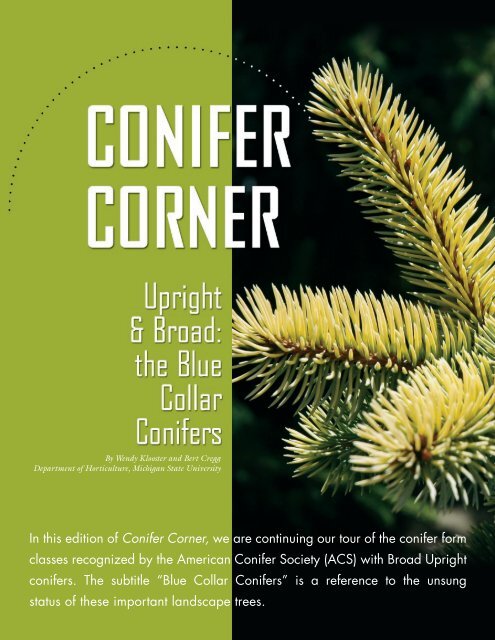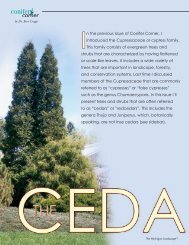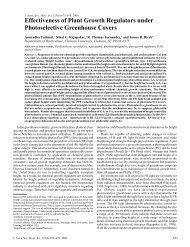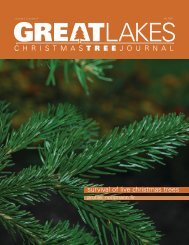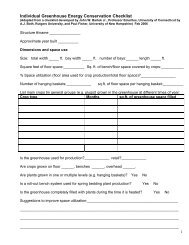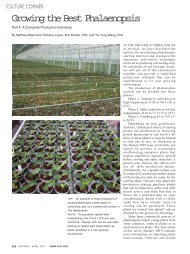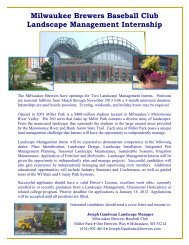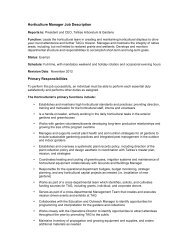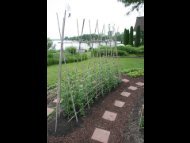Conifer Corner - Department of Horticulture - Michigan State University
Conifer Corner - Department of Horticulture - Michigan State University
Conifer Corner - Department of Horticulture - Michigan State University
- No tags were found...
You also want an ePaper? Increase the reach of your titles
YUMPU automatically turns print PDFs into web optimized ePapers that Google loves.
By Wendy Klooster and Bert Cregg<strong>Department</strong> <strong>of</strong> <strong>Horticulture</strong>, <strong>Michigan</strong> <strong>State</strong> <strong>University</strong>In this edition <strong>of</strong> <strong>Conifer</strong> <strong>Corner</strong>, we are continuing our tour <strong>of</strong> the conifer formclasses recognized by the American <strong>Conifer</strong> Society (ACS) with Broad Uprightconifers. The subtitle “Blue Collar <strong>Conifer</strong>s” is a reference to the unsungstatus <strong>of</strong> these important landscape trees.July 200837
Strong, silent types. Picea abies ‘Parviformis’ (left) and P. pungens ‘Montgomery’(right) provide the backdrop to let other plants shine.If they could, Broad Upright conifers wouldwear Carhartts and carry a lunch bucket. Talkabout no respect, even the definition <strong>of</strong> the categoryis a definition by default. The American <strong>Conifer</strong>Society (ACS) guidelines for form classificationsare similar to those for size, but these categoriesare based on the growth habit (proportion <strong>of</strong>vertical to horizontal growth, and branch structure)rather than growth rate. According to the ACS,if a tree is upright but is not rounded, narrow orweeping it is considered broad upright (seesidebar). As with size classifications, ACS, coniferform distinctions can be a bit subjective and alsodepend upon local growing conditions and treeage. For example, many plants classified as BroadKorean pine (Pinuskoraiensis) is a classicexample <strong>of</strong> a ‘bluecollar’ conifer. Thishardy and reliableplant can set the stagefor other specimens.38 The <strong>Michigan</strong> Landscape
Upright, may start <strong>of</strong>f narrow or pyramidal andthen become more rounded or spreading with age.While broad upright conifers may feel likesecond class citizens compared to elegantfastigiate forms or show-topping irregular forms,it is hard to overestimate their overall importancein landscape design. These are extremely commonforms <strong>of</strong> landscape conifers that serve as thebackbone <strong>of</strong> many landscape designs. The ACSlists over 400 cultivars <strong>of</strong> broad upright conifers;more than any other single form class. What peoplemay not realize, however, is that this categoryincludes trees <strong>of</strong> all sizes from miniature to largeand includes almost all genera <strong>of</strong> conifers. Broadupright conifers are extremely versatile and serveas the backbone <strong>of</strong> many landscapes. Intermediateor large varieties are <strong>of</strong>ten planted in a row or areeven <strong>of</strong>fset a little to form an effective windbreak.Since these trees grow quickly, both upward andoutward, they can be planted at a fairly wide spacingand still provide privacy and protection within afew years. Intermediate trees are sometimesplanted in a row and kept pruned as a hedge, butthis requires regular maintenance. Rememberthat broad upright trees will get rather wide atthe base, so they should not be planted too closeto a structure or walkway.The natural form <strong>of</strong> broad uprights is usuallyso desirable that many landscapes include one asa specimen tree. This is the tree that first drawsthe viewer’s eye and maybe even draws the wholeviewer close in order to feel the foliage or bark.Kerry Gee <strong>of</strong> Gee Farms near Stockbridge,<strong>Michigan</strong>, advises landscapers to spend half <strong>of</strong>their budget on a single specimen tree, and thenuse the other half to fill in with more basic plants.If this sounds extreme, consider that large andunusual trees can cost over a thousand dollarsdue to the time and resources it takes to producethem. Sometimes all that it takes is one look toknow that a tree is worth the price.If the landscape already has a large specimentree, a grouping <strong>of</strong> smaller broad uprights can beused on the other side to give the landscapesymmetry. This contributes balance, one <strong>of</strong> thebasic elements in landscape design. In this case, afew small trees planted together have the samevisual strength as a single large tree. Texture isanother design element and is a good way toprovide variety and interest without disruptingbalance. Texture is achieved by selecting cultivarswith different needle shapes and sizes. The small,compact foliage <strong>of</strong> many Chamaecyparis, forexample, provide a nice contrast to the stiff, sharpedges <strong>of</strong> spruce needles. Trees also come in avariety <strong>of</strong> colors from greens and blues to whitesand yellows. Many green cultivars have yellowcounterparts, such as Chamaecyparis nootkatensis‘Variegata’, which can be very striking. However,it is important to avoid the temptation to plantone <strong>of</strong> each as they can be overwhelming andmake the landscape look like a circus. When usedsparingly, blue or yellow conifers can add just theright amount <strong>of</strong> visual interest and appeal.Pinus koraiensis ‘Silver Ray’,Silver Ray Korean PineJuly 200839


